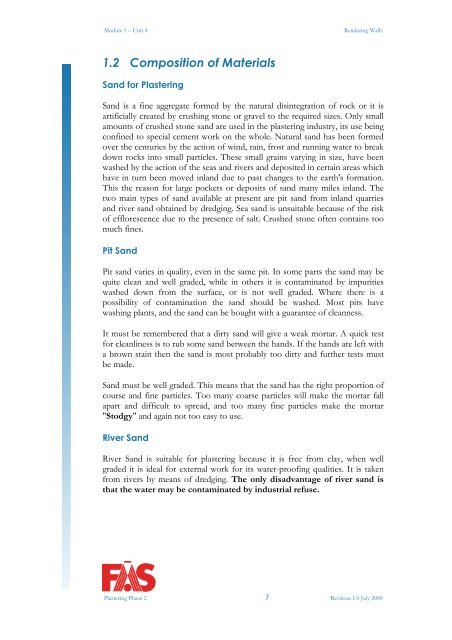TRADE OF PLASTERING - eCollege
TRADE OF PLASTERING - eCollege
TRADE OF PLASTERING - eCollege
Create successful ePaper yourself
Turn your PDF publications into a flip-book with our unique Google optimized e-Paper software.
Module 1 – Unit 4 Rendering Walls<br />
1.2 Composition of Materials<br />
Sand for Plastering<br />
Sand is a fine aggregate formed by the natural disintegration of rock or it is<br />
artificially created by crushing stone or gravel to the required sizes. Only small<br />
amounts of crushed stone sand are used in the plastering industry, its use being<br />
confined to special cement work on the whole. Natural sand has been formed<br />
over the centuries by the action of wind, rain, frost and running water to break<br />
down rocks into small particles. These small grains varying in size, have been<br />
washed by the action of the seas and rivers and deposited in certain areas which<br />
have in turn been moved inland due to past changes to the earth's formation.<br />
This the reason for large pockets or deposits of sand many miles inland. The<br />
two main types of sand available at present are pit sand from inland quarries<br />
and river sand obtained by dredging. Sea sand is unsuitable because of the risk<br />
of efflorescence due to the presence of salt. Crushed stone often contains too<br />
much fines.<br />
Pit Sand<br />
Pit sand varies in quality, even in the same pit. In some parts the sand may be<br />
quite clean and well graded, while in others it is contaminated by impurities<br />
washed down from the surface, or is not well graded. Where there is a<br />
possibility of contamination the sand should be washed. Most pits have<br />
washing plants, and the sand can be bought with a guarantee of cleanness.<br />
It must be remembered that a dirty sand will give a weak mortar. A quick test<br />
for cleanliness is to rub some sand between the hands. If the hands are left with<br />
a brown stain then the sand is most probably too dirty and further tests must<br />
be made.<br />
Sand must be well graded. This means that the sand has the right proportion of<br />
course and fine particles. Too many coarse particles will make the mortar fall<br />
apart and difficult to spread, and too many fine particles make the mortar<br />
"Stodgy" and again not too easy to use.<br />
River Sand<br />
River Sand is suitable for plastering because it is free from clay, when well<br />
graded it is ideal for external work for its water-proofing qualities. It is taken<br />
from rivers by means of dredging. The only disadvantage of river sand is<br />
that the water may be contaminated by industrial refuse.<br />
Plastering Phase 2 3 Revision 1.0 July 2008

















